
USS Becuna (SS/AGSS-319), a Balao-class submarine, is a former ship of the United States Navy named for the becuna, a pike-like fish of Europe. She was designated a National Historic Landmark for her service in World War II, for which she earned four battle stars. She presently serves as a museum ship at the Independence Seaport Museum in Philadelphia, Pennsylvania.

The New Jersey Historical Society is a historical society and museum located in Newark, Essex County, New Jersey, United States. The Historical Society is housed in the former headquarters of the Essex Club. It has two floors of exhibition space, a gift shop, and a hall for lectures. The NJHS offers occasional Newark walking tours. The Society publishes the academic journal, New Jersey History.

Carnegie Museums of Pittsburgh are four museums that are operated by the Carnegie Institute headquartered in the Carnegie Institute complex in the Oakland neighborhood of Pittsburgh, Pennsylvania. The Carnegie Institute complex that includes the original museum, recital hall, and library was added to the National Register of Historic Places on March 30, 1979.

Morristown National Historical Park is a United States National Historical Park, headquartered in Morristown, New Jersey, consisting of four sites important during the American Revolutionary War: Jockey Hollow, the Ford Mansion, Fort Nonsense and the New Jersey Brigade Encampment site.

Hale Farm and Village is a historic property of the Western Reserve Historical Society in Bath Township, Summit County, Ohio, United States. It is within the boundaries of the Cuyahoga Valley National Park. Hale Farm was the original homestead of Jonathan Hale, a Connecticut farmer who migrated to the Western Reserve in 1810. In 1973 Hale Farm was listed on the National Register of Historic Places as the Jonathan Hale Homestead. The Hale House was built in 1825.

The Federal Reserve Bank of Cleveland is the Cleveland-based headquarters of the U.S. Federal Reserve System's Fourth District. The district is composed of Ohio, western Pennsylvania, eastern Kentucky, and the northern panhandle of West Virginia. It has branch offices in Cincinnati and Pittsburgh. The check processing center in Columbus, Ohio, was closed in 2005. The chief executive officer and president is Loretta Mester.

Harpers Ferry National Historical Park is located at the confluence of the Potomac and Shenandoah rivers in and around Harpers Ferry, West Virginia. The park includes land in the Shenandoah Valley in Jefferson County, West Virginia; Washington County, Maryland and Loudoun County, Virginia. The park is managed by the National Park Service, an agency of the U.S. Department of the Interior. Originally designated Harpers Ferry National Monument in 1944, the park was declared a National Historical Park by the U.S. Congress in 1963. The park includes the historic town of Harpers Ferry, notable as a center of 19th-century industry and as the scene of John Brown's failed abolitionist uprising. Consisting of almost 4,000 acres (16 km2), it includes the site of which Thomas Jefferson once wrote, "The passage of the Potomac through the Blue Ridge is perhaps one of the most stupendous scenes in Nature" after visiting the area in 1783. Due to a mixture of historical events and ample recreational opportunities, all within 50 miles (80 km) of Washington, D.C., the park was listed on the National Register of Historic Places on October 15, 1966. The Park's Superintendent is presently Tyrone Brandyburg.

Effie M. Morrissey was a schooner skippered by Robert Bartlett that made many scientific expeditions to the Arctic, sponsored by American museums, the Explorers Club and the National Geographic Society. She also helped survey the Arctic for the United States Government during World War II. She is currently designated by the United States Department of the Interior as a National Historic Landmark as part of the New Bedford Whaling National Historical Park. She is the State Ship of Massachusetts.

James A. Garfield National Historic Site is a United States National Historic Site located in Mentor, Ohio. The site preserves the property associated with the 20th President of the United States, James A. Garfield, and includes the first presidential library established in the United States.
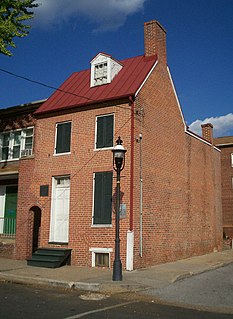
The Edgar Allan Poe House and Museum, located at 203 North Amity St. in Baltimore, Maryland, is the former home of American writer Edgar Allan Poe in the 1830s. The small unassuming structure, which was opened as a writer's house museum in 1949, is a typical row home. It was designated a National Historic Landmark in 1972.
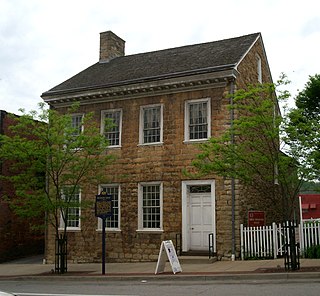
The David Bradford House is a historic house museum at 175 South Main Street in Washington, Pennsylvania. Completed in 1788, it was the home of David Bradford, a leader of the Whiskey Rebellion. It has both architectural and historic importance, and was designated a National Historic Landmark in 1983. It is open weekly between April and November, or by appointment.

The Coffin House is a National Historic Landmark located in the present-day town of Fountain City in Wayne County, Indiana. The two-story, eight room, brick home was constructed circa 1838–39 in the Federal style. The Coffin home became known as the "Grand Central Station" of the Underground Railroad because of its location where three of the escape routes to the North converged and the number of fugitive slaves who passed through it.
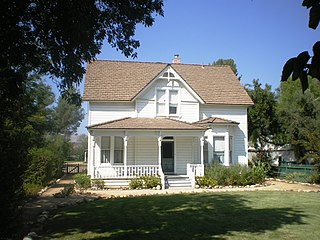
The historic Simi Adobe–Strathearn House served as the headquarters of Rancho Simi, also known as Rancho San José de Nuestra Senora de Altagracia y Simi, one of the land grants in Alta California by the Spanish government. The name derives from Shimiji, the name of the Chumash village here before the Spanish. Rancho Simi was the earliest Spanish colonial land grant within Ventura and Santa Barbara Counties. At 113,000 acres, Rancho Simi was one of the state's largest land grants.
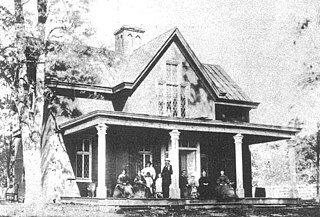
Tudor Hall is a historic home located at Bel Air, Harford County, Maryland, United States. It is a 1 1⁄2-story Gothic Revival cottage built of painted brick. The house was built as a country retreat by Junius Brutus Booth (1796–1852) from Plates 44 and 45, Design XVII, of The Architect, by William H. Ranlett, 1847. However, Booth never lived in Tudor Hall, because he died before it was completed. His son Edwin Booth lived there only briefly on his return from California before he moved the family back into Baltimore. But his other son, John Wilkes Booth, lived there with his mother, brother Joseph, and two sisters from December 1852 through most of 1856.

The Byers–Evans House Museum is a historic house museum in Denver, Colorado, United States.

Old Sardinia Town Hall, also known as the Sardinia Meeting House and First Baptist Church of Sardinia, is a historic town hall located at Sardinia in Erie County, New York. It was built between 1828 and 1830, and is a two-story, transitional Federal / Greek Revival style frame building. It originally housed a Baptist church congregation. The building was renovated in the early-1930s and housed a local community hall until deeded to the town of Sardinia in 1945 for use as a town hall. It is now home to the Sardinia Historical Society and Museum.

Ashton Villa is a fully restored, historic home located on the corner of 24th and Broadway in Galveston, Texas, United States. Constructed in 1859, it was one of the first brick structures in Texas.

The Wade Park District is an historic district on the National Register of Historic Places, located in the University Circle neighborhood on the east side of Cleveland, Ohio. The district, which covers roughly 650 acres, is bounded by Chester Avenue and Euclid Avenue on the south, East Boulevard to the east and E. 105th Street to the west. The district, which includes seven separate buildings, features several of the city's cultural institutions, as well as the park of the same name.
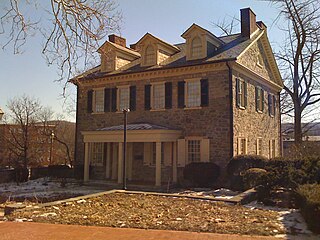
Trout Hall is a historic home located at Allentown, Lehigh County, Pennsylvania. It is the oldest home in Allentown, built between 1768 and 1770, and is a 2 1/2-story, stone dwelling in the Georgian style. It was built as a summer home by James Allen, the third son of William Allen, founder of Allentown. Today, it houses the library and museum of the Lehigh County Historical Society.
























